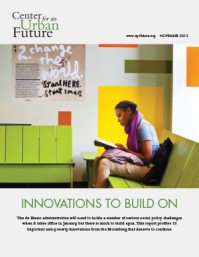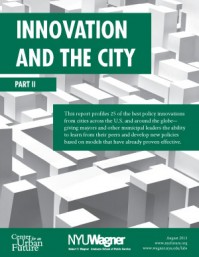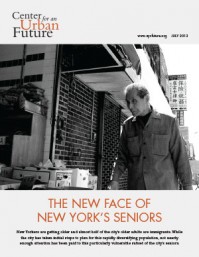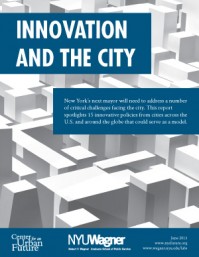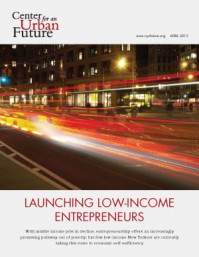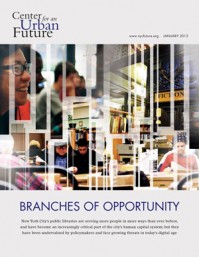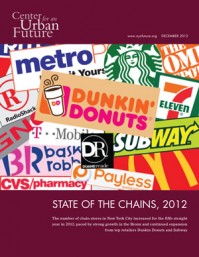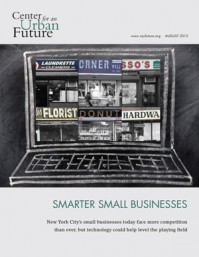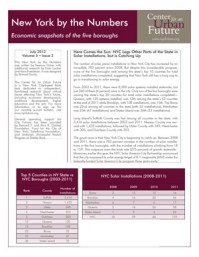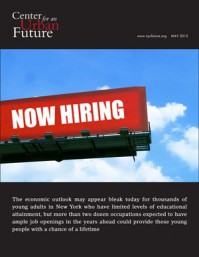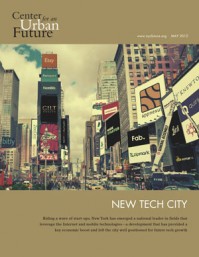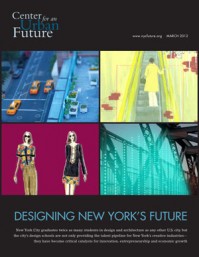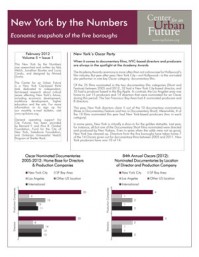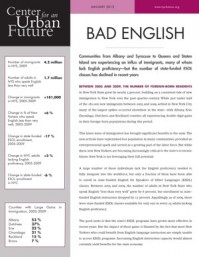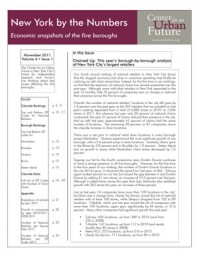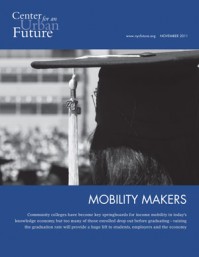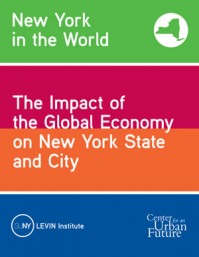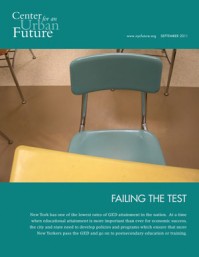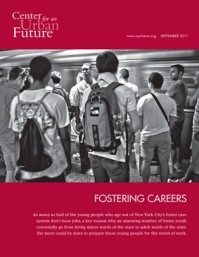Report - November 2013
Innovations to Build OnThe de Blasio administration will need to tackle a number of serious social policy challenges when it takes office in January, but there is much to build upon. This report profiles 10 important anti-poverty innovations from the Bloomberg administration that deserve to continue.
Report - August 2013
Innovation and the City, Part IIThis report profiles 25 of the best policy innovations from cities across the U.S. and around the globe—giving mayors and other municipal leaders the ability to learn from their peers and develop new policies based on models that have already proven effective.
Report - July 2013
The New Face of New York’s SeniorsNew Yorkers are getting older and almost half of the city’s older adults are immigrants. While the city has taken initial steps to plan for this rapidly diversifying population, not nearly enough attention has been paid to this particularly vulnerable subset of the city’s seniors.
Report - June 2013
Innovation and the CityNew York’s next mayor will need to address a number of critical challenges facing the city. This report spotlights 15 innovative policies from cities across the U.S. and around the globe that could serve as a model.
Report - June 2013
Completion DayCommunity colleges are a critical resource for a growing number of New Yorkers and a key component of the state's economic competitiveness. But they are taken for granted by policymakers and continue to face enormous challenges in graduating students.
Report - April 2013
Launching Low-Income EntrepreneursWith middle-income jobs in decline, entrepreneurship offers an increasingly promising pathway out of poverty; but few low-income New Yorkers are currently taking this route to economic self-sufficiency.
Report - January 2013
Branches of OpportunityNew York City’s public libraries are serving more people in more ways than ever before, and have become an increasingly critical part of the city’s human capital system; but they have been undervalued by policymakers and face growing threats in today’s digital age.
Report - December 2012
State of the Chains, 2012Our fifth annual ranking of national retailers in NYC shows that the number of chain stores in New York City increased for the fifth straight year in 2012, paced by strong growth in the Bronx and continued expansion from top retailers Dunkin Donuts and Subway.
Report - August 2012
Smarter Small BusinessesThis report finds that far too many of NYCs small businesses still arent using websites, online ads and other technology tools, a huge missed opportunity at a time when small firms face increasing competition from national chains and online companies.
Report - July 2012
Here Comes the SunThis edition of New York by the Numbers reveals that New York City lags behind the rest of the state when it comes to installing solar energy panels in residential, commercial and government buildings, but is beginning to catch up.
Report - May 2012
Now HiringWhile young adults without a college degree are among those who are having the hardest time finding decent paying jobs today, this report provides a ray of hope. It identifies more than two dozen occupations in New York City that are expected to have ample job openings in the years ahead which pay decent salaries and which are accessible to young adults with low levels of educational attainment.
Report - May 2012
New Tech CityRiding a wave of start-ups, New York has emerged as a national leader in fields that leverage the Internet and mobile technologies—a development that has provided a key economic boost and left the city well positioned for future tech growth
Report - March 2012
Designing New York’s FutureNew York City graduates twice as many students in design and architecture as any other U.S. city, but the city's design schools are not only providing the talent pipeline for New York's creative industries—they have become critical catalysts for innovation, entrepreneurship and economic growth.
Report - February 2012
New York’s Oscar PartyThis edition of New York by the Numbers reveals that when it comes to documentary films, NYC-based directors and producers are always in the spotlight at the Academy Awards.
Report - January 2012
Bad EnglishCommunities from Albany and Syracuse to Queens and Staten Island are experiencing an influx of immigrants, many of whom lack English proficiency—but the number of state-funded ESOL classes has declined in recent years.
Report - November 2011
Chained UpOur fourth annual ranking of national retailers in NYC shows that the growth of chain stores has slowed over the past year. While the number of chain stores is up by 1.6 percent over last year, more retailers reduced their presence in the city than expanded. And though Dunkin Donuts tops our list again, for the first time it did not have a net gain in stores.
Report - November 2011
Mobility MakersThis report finds that community colleges are crucial platforms for economic mobility in today's knowledge economy, but shows that too few of those enrolled in these institutions actually graduate.
Report - October 2011
New York in the WorldNew York in the World: This new report jointly issued by the Center for an Urban Future and the SUNY Levin Institute provides the first comprehensive impact of how globalization has impacted NYC and NYS. It finds that no state has benefited more and suffered worse from globalization than New York.
Report - September 2011
Failing the TestIn today's knowledge economy, those without a high school diploma are literally at the end of the line when applying for jobs, particularly those that pay decent wages. Unfortunately, the GED system has failed to provide a second chance to these New Yorkers, with only one percent of those eligible getting their GED each year and very few of those who do attain their GED going on to postsecondary education and training. This report examines several options for improving the GED system: whether New York should charge a fee for test takers, the benefits and costs of the official practice test, availability and quality of preparatory instruction and providing a bridge from GED to postsecondary education and training.
Report - September 2011
Fostering CareersThis major new study reveals that an alarming share of young people who age out of New York City's foster care system are failing to obtain and hold on to jobs, and that part of the problem is that city government and foster care agencies are either not adequately focused on providing workforce preparation services to these youngsters or not equipped to do so. The study concludes that these dismal employment outcomes are a leading reason why an unacceptably large number of foster care alumni go from being minor wards of the state to adult wards of the state.

